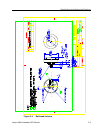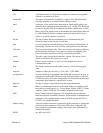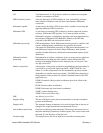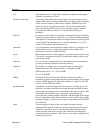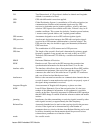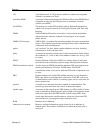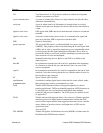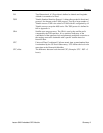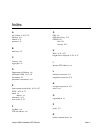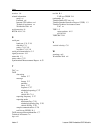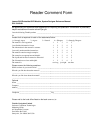
Lassen-SK8 Embedded GPS Module Glossary-7
Glossary
range A term used to refer to the distance radio signals can travel before they
must be received or repeated due to loss of signal strength, the curvature
of the earth and the noise introduced because of moisture in the air
surrounding the earth's surface.
range rate The rate of change of range between the satellite and receiver. The range
to a satellite changes due to satellite and observer motions. Range rate is
determined by measuring the Doppler shift of the satellite beacon carrier.
read-only memory Memory whose contents can be read, but not changed. Information is
placed into ROM only once. The contents of ROM are not erased when
the system unit's power is turned off.
real time clock An electronic clock, usually battery powered, that keeps current time.
Used by a GPS receiver during a warm or hot start to determine where to
search for GPS satellite signals.
relative positioning The process of determining the vector distance between two points and
the coordinates of one spot relative to another. This technique yields GPS
positions with greater precision than a single point positioning mode can.
rise/set time Refers to the period during which a satellite is visible; i.e., has an
elevation angle that is above the elevation mask. A satellite is said to
“rise” when its elevation angle exceeds the mask and “set” when the
elevation drops below the mask.
ROM Read-Only Memory.
RS-232 A communication standard for digital data. Specifies a number of signal
and control lines. RS-232 is often associated with a 25 pin connector
called a DB-25.
RTCM Radio Technical Commission for Maritime Services. Commission that
recommends standards for differential GPS services. “RTCM
Recommended Standards For Differential GPS Service,” prepared by
RTCM Special Committee No. 104 (RTCM SC-104), defines a
communication protocol for sending GPS differential corrections from a
differential reference station to remote GPS receivers.
satellite masks As satellites approach the horizon, their signals can become weak and
distorted, preventing the receiver from gathering accurate data. Satellite
masks enable you to establish criteria for using satellite data in a position
solution. There are three types of satellite masks: Elevation, SNR, and
PDOP.
SA Selective Availability. This is the name of the policy and the
implementation scheme by which unauthorized users of GPS will have
their accuracy limited to 100 meters 2D RMS horizontal and 156 meters
2D RMS vertical.
SEP Spherical Error Probability. The radius of a sphere such that 50% of the
position estimates will fall within the surface of the sphere.
2-D Two Dimensional. A 2-D position is defined as latitude and longitude.
Altitude is assumed to be fixed.



